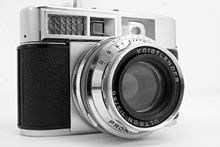Ultron
The Ultron is a lens developed by Albrecht W. Tronnier and produced by Voigtländer from 1950 onwards for 35 mm cameras . The lens structure of the Ultron lenses follows a Gaussian double lens . The best known is the Ultron f = 2.0 with a leading imaging performance for the early post-war period.
The Ultron f2.0 lens with 50 mm focal length is based on a design that is published in US patents USPat 2,627,204 (six lenses in four groups according to the adjacent drawing) and 2,627.205 from 1953. It is a modified Gaussian double lens , made with six lenses in five groups using special glasses of the time. It was used in Prominent , Vito III and Vitessa Voigtländer cameras . By using the coating of lens surfaces, which has just become available, the disadvantages of a relatively large number of free-standing lens surfaces that would otherwise occur could be largely avoided. Compared to the Biotar type (6 lenses in 4 groups), one more radius of curvature was available for the correction, as only two lenses were cemented.
Tronnier had already flirted with a similar design for xenon in the mid-1930s . Prototypes of an Ultron f = 1.9 for the Vito III are documented.
literature
- H.-M.Brandt: The Photo Lens , Vieweg & Sohn, Braunschweig, 1956
Individual evidence
- ↑ a b page no longer available , search in web archives: Lens Collector's Vademecum Online version

